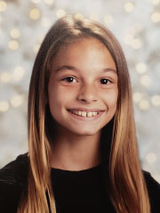Surgical correction of macrodactyly: Phoebe's story
Surgical correction of macrodactyly: Phoebe's story
Phoebe, 11, wants to be a professional soccer player when she grows up. She is already making headway toward her goal by playing on the South Jersey Select Team. According to her mother, Phoebe has always been a "stand-out" child, and not just on the soccer field. When she was an infant, she earned the nickname “Famous Phoebe” among their family and friends for her participation in a genetic study on macrodactyly at Children’s Hospital of Philadelphia (CHOP).

When Phoebe was 2 weeks old, her mother, Kate, noticed that her right hand was slightly larger than her left hand. Kate brought it to the attention of Phoebe’s pediatrician, and the family was referred to CHOP.
The family traveled from their home in southern New Jersey to CHOP, where Phoebe was diagnosed with macrodactyly. Macrodactyly is an extremely rare congenital anomaly in which there is an overgrowth of the bones and soft tissue in the fingers or toes, causing them to become abnormally large.
Macrodactyly affects the hands more often than the feet, and typically appears in a few fingers on the affected hand or toes on the foot. While the condition is benign, it can cause the affected hand or foot to be cosmetically different and often affects normal function.
Monitoring and treatment planning
The treatment for macrodactyly is typically a series of operations combining orthopedic surgery and plastic surgery. The operations take place throughout childhood — as the child is growing — and each procedure is followed by occupational or physical therapy to help the child recover full use of the affected hand or foot.
Doctors at CHOP monitored the size of Phoebe's fingers as she grew, and timed planned surgery to halt the growth and create the most normal-appearing hand in adulthood. During Phoebe's early childhood, the fingers on her right hand and her pinky finger on her left hand, grew to be as large as an adult’s fingers.
Beginning corrective treatment for macrodactyl

When Phoebe was 9, it was time for the first step in her corrective treatment plan. Her family met with Apurva S. Shah, MD, MBA, an orthopedic surgeon who specializes in pediatric hand and upper extremity surgery. They talked through the approach to corrective surgery and the fact that multiple surgeries would produce the best functional and cosmetic outcomes for Phoebe.
Phoebe’s first surgery involved removing excess tissue (a procedure called "debulking") to cosmetically correct the appearance of her middle finger and close the related growth plate to prevent further growth.
Her second surgery involved a repeat debulking of her middle finger and the closure of growth plates in her ring and index fingers.
Phoebe's third surgery included closing the growth plates in her palm and thumb. Her pinky was not affected by overgrowth.
“To prepare us for the first procedure, Dr. Shah told us exactly what the surgeons were going to do to Phoebe’s hand,” says Kate. “He showed us X-rays of her fingers and explained how much they would debulk her finger. Everything he told us helped us understand what to expect after the surgery.”
Involving Phoebe in the discussion
From the start, Dr. Shah made Phoebe part of the conversation about her treatment.
“I love Dr. Shah,” says Kate. “He talks to her first so that she is as involved as she can be in her own treatment.”
Phoebe’s parents were also prepared to help her recover after each procedure
“After the surgery, we got the soft cast off and started occupational therapy,” Kate says. “We worked on strengthening, stretching and mobility.”
Phoebe received her post-operative care with occupational therapist Meagan Pehnke, MS, OTR/L, CHT, CLT, at CHOP at Virtua. Meagan taught Phoebe exercises to regain her motion and improve the appearance of her scar that she continued to use following her additional operations. Phoebe was motivated to start therapy and exercises after each procedure, regardless of pain, so that she could get back on the soccer field as quickly as possible.
According to Kate, "She’s not always happy to do the therapy but she has amazing mobility in that hand now, so we’re doing something right.”
Advice from the patient
It’s been a year since Phoebe’s third surgery. She’ll need additional surgeries on her left hand, as well as her right, before she stops growing.
Looking back, Phoebe has some advice for kids with her condition who need to have surgery: “It’s not really that bad if you don’t worry about it,” she says. “When you don’t worry, everything is just easier.”
Phoebe is now back to the things she loves: Hanging out with her friends, going to school and playing soccer on two competitive teams.
"She’s gone through so much in her young life, but she still gets up with a smile every day," says her mom. "She's confident she’s going to be a professional soccer player when she grows up. She's so inspirational … and when she smiles at you, it's infectious.”